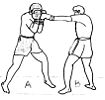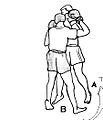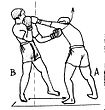Boxing
Boxing is a combat sport in which two people, usually wearing protective gloves, throw punches at each other for a predetermined amount of time in a boxing ring.
History
Rules
Technique
In a fully upright stance, the boxer stands with the legs shoulder-width apart and the rear foot a half-step in front of the lead man. Right-handed or orthodox boxers lead with the left foot and fist (for most penetration power). Both feet are parallel, and the right heel is off the ground. The lead (left) fist is held vertically about six inches in front of the face at eye level. The rear (right) fist is held beside the chin and the elbow tucked against the ribcage to protect the body. The chin is tucked into the chest to avoid punches to the jaw which commonly cause knock-outs and is often kept slightly off-center. Wrists are slightly bent to avoid damage when punching and the elbows are kept tucked in to protect the ribcage.Some boxers fight from a crouch, leaning forward and keeping their feet closer together. The stance described is considered the "textbook" stance and fighters are encouraged to change it around once it's been mastered as a base. Case in point, many fast fighters have their hands down and have almost exaggerated footwork, while brawlers or bully fighters tend to slowly stalk their opponents. In order to retain their stance boxers take 'the first step in any direction with the foot already leading in that direction.
Different stances allow for bodyweight to be differently positioned and emphasized; this may in turn alter how powerfully and explosively a type of punch can be delivered. For instance, a crouched stance allows for the bodyweight to be positioned further forward over the lead left leg. If a lead left hook is thrown from this position, it will produce a powerful springing action in the lead leg and produce a more explosive punch. This springing action could not be generated effectively, for this punch, if an upright stance was used or if the bodyweight was positioned predominantly over the back leg. [46] Mike Tyson was a keen practitioner of a crouched stance and this style of power punching.The preparatory positioning of the bodyweight over the bent lead leg is also known as an isometric preload.
Left-handed or southpaw fighters use a mirror image of the orthodox stance, which can create problems for orthodox fighters unaccustomed to receiving jabs, hooks, or crosses from the opposite side. The southpaw stance, conversely, is vulnerable to a straight right hand.
North American fighters tend to favor a more balanced stance, facing the opponent almost squarely, while many European fighters stand with their torso turned more to the side. The positioning of the hands may also vary, as some fighters prefer to have both hands raised in front of the face, risking exposure to body shots.
Jab - A quick, straight punch thrown with the lead hand from the guard position. The jab extends from the side of the torso and typically does not pass in front of it. It is accompanied by a small, clockwise rotation of the torso and hips, while the fist rotates 90 degrees, becoming horizontal upon impact. As the punch reaches full extension, the lead shoulder can be brought up to guard the chin. The rear hand remains next to the face to guard the jaw. After making contact with the target, the lead hand is retracted quickly to resume a guard position in front of the face.
- The jab is recognized as the most important punch in a boxer's arsenal because it provides a fair amount of its own cover and it leaves the least amount of space for a counter punch from the opponent. It has the longest reach of any punch and does not require commitment or large weight transfers. Due to its relatively weak power, the jab is often used as a tool to gauge distances, probe an opponent's defenses, harass an opponent, and set up heavier, more powerful punches. A half-step may be added, moving the entire body into the punch, for additional power. Some notable boxers who have been able to develop relative power in their jabs and use it to punish or wear down their opponents to some effect include Larry Holmes and Wladimir Klitschko.. .
The modern boxing stance differs substantially from the typical boxing stances of the 19th and early 20th centuries. The modern stance has a more upright vertical-armed guard, as opposed to the more horizontal, knuckles-facing-forward guard adopted by early 20th century hook users such as Jack Johnson .
- At the same time, the knees push upwards quickly and the torso and hips rotate anti-clockwise and the rear heel turns outward, mimicking the body movement of the cross. The strategic utility of the uppercut depends on its ability to "lift" the opponent's body, setting it off-balance for successive attacks. The right uppercut followed by a left hook is a deadly combination employing the uppercut to lift the opponent's chin into a vulnerable position, then the hook to knock the opponent out.
Defense
There are several basic maneuvers a boxer can use in order to evade or block punches, depicted and discussed below.
- Weight is also transferred from the rear foot to the lead foot, resulting in the rear heel turning outwards as it acts as a fulcrum for the transfer of weight. Body rotation and the sudden weight transfer give the cross its power. Like the jab, a half-step forward may be added. After the cross is thrown, the hand is retracted quickly and the guard position resumed. It can be used to counter punch a jab, aiming for the opponent's head (or a counter to a cross aimed at the body) or to set up a hook. The cross is also called a "straight" or "right", especially if it does not cross the opponent's outstretched jab.
- At the same time, the lead foot pivots clockwise, turning the left heel outwards. Upon contact, the hook's circular path ends abruptly and the lead hand is pulled quickly back into the guard position. A hook may also target the lower body and this technique is sometimes called the "rip" to distinguish it from the conventional hook to the head. The hook may also be thrown with the rear hand. Left hookers include Notable to Joe Frazier , in Roy to to Jr in Jones . and Mike Tyson .
- Sway or fade - To anticipate a punch and move the upper body or head back so that it misses or has its force appreciably lessened. Also called "rolling with the punch" or "Riding The Punch".
- Duck or break - To drop down with the back straight so that a punch aimed at the head glances or misses entirely.
- Slip -Slippingrotates the body slightly so that an incoming punch passes harmlessly next to the head. As the opponent's punch arrives, the boxer rotates sharply the hips and shoulders. This turns the chin sideways and allows the punch to "slip" past. Muhammad Aliwas famous for extremely fast and close slips, as was an early Mike Tyson.
- Parry / block - Parrying or blocking uses the boxer's shoulder, hands or arms as defensive tools to protect against incoming attacks. A block generally receives a punch while a parry tends to deflect it. A "palm", "catch", or "cuff" is a defense which intentionally takes the incoming punch on the palm portion of the defender's glove.
- The cover-up - Covering up is the last opportunity (other than rolling with a punch) to avoid an incoming strike to an unprotected face or body. Generally speaking, the hands are held high to protect the head and chin and the forearms are tucked against the torso to impede body shots. When protecting the body, the boxer rotates the hips and lets incoming punches "roll" off the guard. To protect the head, the boxer presses both fists against the front of the face with the forearms parallel and facing outwards. This type of guard is weak against attacks from below.
- The clinch - Clinching is a form of trapping or a rough form of grappling and occurs when the distance between both fighters has closed and straight punches cannot be employed. In this situation, the boxer attempts to hold or "tie up" the opponent's hands so he is unable to throw hooks or uppercuts . To perform a clinch, the boxer loops both hands around the outside of the opponent's shoulders, scooping back under the forearms to grasp the opponent's arms tightly against his own body. In this position, the opponent's arms are pinned and cannot be used to attack. Clinching is a temporary match state and is quickly dissipated by the referee. Clinching is technically against the rules, and in amateur fights points are deducted fairly quickly for it. It is unlikely, however, to see points deducted for a clinch in professional boxing.
Health benefits
As active and dynamic sports, boxing provides the following benefits:
- Fat burning.
- Increased muscle tone.
- Strong bones and ligaments.
- Increased cardiovascular fitness.
- Muscular endurance.
- Improved core stability.
- Increased strength and power.
- Stress relief.
- Improved co-ordination and body awareness.
- Greater confidence and self-esteem.
With a careful and thoughtful approach, boxing can be quite beneficial to health. For example, Gemma Ruegg, a two-weight regional champion from Bournemouth in Dorset, boxed throughout her pregnancy and returned to the ring three weeks after giving birth to her daughter. Earlier, boxing helped her to get rid of alcohol addiction and depression
Boxing Hall of Fame
The sport of boxing has two internationally recognized boxing halls of fame; the International Boxing Hall of Fame (IBHOF) . In 2013, The Boxing Hall of Fame Las Vegas opened inLas Vegas, NVfounded bySteve Lott, former assistant manager forMike Tyson.
The International Boxing Hall of Fame opened in Canastota in 1989. The first inductees in 1990 included Jack Johnson, Benny Leonard , Jack Dempsey, Henry Armstrong, Sugar Ray Robinson , Archie Moore , and Muhammad Ali. Other world-class figures include Salvador and Rum Cay Sanchez to, in Jose Napoles , to Roberto "Manos de Piedra" Duran, Ricardo in Lopez , Gabriel do Oeste "the Flash" Elorde , in Vicente Saldivar , Ismael in Laguna, Eusebio Pedroza, in Carlos in Monzón, Azumah in Nelson to, in Rocky Marciano , Pipino Cuevas andKen Buchanan . The Hall of Fame's induction ceremony is held every June as part of a four-day event. The fans who come to Canastota for the Induction Weekend are treated to a number of events, including scheduled autograph sessions, boxing exhibitions, a parade featuring past and present inductees, and the induction ceremony itself.
The Boxing Hall of Fame Las Vegas features the $ 75 million ESPN Classic Sports fight film and tape library and radio broadcast collection. The collection includes the fights of all the great champions including: Muhammad Ali , Mike Tyson , George Foreman , Roberto Durán , Marvin Hagler , Jack Dempsey , Joe Louis , Joe Frazier , Rocky Marciano and Sugar Ray Robinson . It is this exclusive fight film library that will separate the Boxing Hall of Fame Las Vegas from the other halls of fame which do not have rights to any video of their sports.The inaugural inductees included Muhammad Ali Henry Armstrong , Tony Canzoneri,Ezzard Charles,Julio César Chávez Sr. ,Jack Dempsey,Roberto Durán,Joe Louis, and Sugar Ray Robinson
Governing and sanctioning bodies
- Governing Bodies
- British Boxing Board of Control (BBBofC)
- European Boxing Union (EBU)
- Nevada State Athletic Commission (NSAC)
- Major Sanctioning Bodies
- World Boxing Association (WBA)
- World Boxing Council (WBC)
- International Boxing Federation (IBF)
- World Boxing Organization (WBO)
- Intermediate
- International Boxing Organization (IBO)
- Novice
- Intercontinental Boxing Federati (IBFed)
- Amateur
- International Boxing Association (AIBA; now also professional)
Boxing rankings
There are various organization and websites, that rank boxers in both weight class and pound-for-pound manner.
- Transnational Boxing Rankings Board ( ratings )
- ESPN ( ratings )
- The Ring ( ratings )
- BoxRec ( ratings )
- Fightstat (rating)
- Bob and weave - Bobbing moves the head laterally and beneath an incoming punch. As the opponent's punch arrives, the boxer bends the legs quickly and simultaneously shifts the body either slightly right or left. Once the punch has been evaded, the boxer "weaves" back to an upright position, emerging on either the outside or inside of the opponent's still-extended arm. To move outside the opponent's extended arm is called "bobbing to the outside". To move inside the opponent's extended arm is called "bobbing to the inside". Joe Frazier, Jack Dempsey, Mike Tyson and Rocky Marciano were masters of bobbing and weaving.
















No comments
New comments are not allowed.